Cross-section Microscopy Analysis of Exterior Paints: Taliaferro-Cole House (Block 13, Building 40), Williamsburg, Virginia
Colonial Williamsburg Foundation Library
Research Report Series - 1740
Colonial Williamsburg Foundation
Library
Williamsburg, Virginia
2012
Cross-Section Microscopy Analysis of Exterior Paints
Taliaferro-Cole House
(Block 13, Building 40)
Williamsburg, Virginia
Table of Contents
| Purpose | 1 |
| Sampling Procedures | 1 |
| Results of Cross-Section Analysis | 2 |
| Results of Binding Media Analysis with Fluorochrome Stains | 7 |
| Results of Pigment Identification | 9 |
| Results of Color Measurement | 10 |
| Conclusion | 11 |
| Appendix | |
| Sampling Memorandum | 12 |
| Cross-Section Preparation Procedures | 13 |
| Binding Media Analysis Procedures | 13 |
| Pigment Identification Procedures | 13 |
| Color Measurement Procedures | 14 |
| Contact Sheets of Cross-Section Photomicrographs | 15 |
Cross-Section Microscopy Analysis of Exterior Paints
| Structure: | Taliaferro-Cole House, Colonial Williamsburg Foundation |
|---|---|
| Requested by: | Edward A. Chappell, Director, Architectural Research Department |
| Funded by: | A Fidelity Foundation Grant to Colonial Williamsburg Foundation |
| Conservator: | Natasha K. Loeblich, Architectural Paint Analyst, Architectural Research Dept. |
| Consultant: | Susan L. Buck, Ph.D. Conservator and Paint Analyst |
| Date: | March 26, 2007 |
Purpose
The goal of this project is to use cross-section microscopy to identify the early finishes, if they are present, on samples from the Taliaferro-Cole House. Edward Chappell took these exterior samples from the cornice, a window, and a weatherboard on August 22, 2006.
The house is thought to have been built in two periods, the west side in the second half of the eighteenth century and the east side between 1815-1834. Even in its earliest configuration, the house was two stories tall, and the first-floor front room off Duke of Gloucester Street may have served as a store. The house was restored in 1940-41, and at that time much of the original exterior fabric was found to be in good condition and was left in place.1 Some sections of the cornice are believed to have survived from the first period house with additions added in the second period. The window frames and sashes on the west elevation are thought to date to the first period. Many weatherboards on the west elevation are also believed to be original to the first period.
Sampling Procedures
Eight samples were taken from the east and west exterior elevations of the house. Six samples were taken from the cornice on the east elevation, one sample from the west elevation weatherboards, and one sample from the north first-floor window on the west elevation. The woodwork samples were lifted with an X-acto blade by Chappell. The samples were collected on site in labeled paper envelopes and each was given a unique number corresponding to the recorded sample locations. The exact sample locations are:
| TC1 | East cornice, bottom cyma of bed molding, bottom edge, 1' 2" south of north window |
| TC2 | East cornice, fillet of bed molding between cyma and ovolo, 1' south of north window |
| TC3 | East cornice, lower fascia immediately below cymatium, at south side of ninth modillion, counting from north (front) |
| TC4 | East cornice, lower fascia, 1" above bed molding, 2" south of ninth modillion, counting from north |
| TC5 | East cornice, ninth modillion, counting from north, lower south edge 1" out from fascia |
| TC6 | East cornice, middle of soffit 3" south of ninth modillion, counting from north |
| TC7 | West wall, eight weatherboard, counting from bottom, 2' 2" south of north first-floor window, at top adjoining weatherboard above |
| TC8 | West wall, north first-floor window, north jamb, inner edge, 1" below top sash |
Results of Cross-section Analysis
Six samples were taken from areas of the cornice on the east face of the building. This portion of the building was added in the second period of construction in 1815-1834, but sections of the first period cornice may have been reused on this face. The samples from the cornice have more paint evidence than the samples taken from a window and a weatherboard on the west elevation which should be first period construction. Neither of those samples yielded much early paint evidence, probably due to loss of the early paints through wear and weathering. Therefore it is difficult to date the cornice to the first or second period of construction using paint archeology.
In the most complete cross-sections from the cornice there are four generations of early dark cream-colored paint and one light brown paint before many generations of later paint were applied. The earliest paints are coarsely ground with large clumps of pigments and accumulations of grime on their surfaces. They have a muted, orange autofluorescence in ultraviolet light and have an oil binder, as discussed on page six. The first generation of finish is a dark cream-colored paint that is thickly applied with a large accumulation of grime and mold above it. Generation two is a slightly lighter cream-colored paint. In some samples there are large orange pigment particles or contaminants discernible in generation three which would have produced a distincly colored light brown layer. Generations four and five are dark cream-colored layers. Generation six is composed of a whitish base coat and a resinous top coat with a bluish autofluorescence in ultraviolet light. This generation has pigment clumps with a bright yellow- green autofluorescence characteristic of zinc white. The presence of this pigment dates this layer to 1845 or after when zinc white went into commercial production. Above generation six are fourteen more generations of cream-colored and white paints.
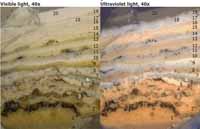 Sample TC3 from the lower fascia below cymatium on the east cornice
Sample TC3 from the lower fascia below cymatium on the east cornice
The cross-section images shown below also have evidence of the earliest dark cream-colored layers. The first generation of paint has bits of wood cells at the bottom indicating that it is the earliest layer even though the wood substrate is missing. It is possible to see large clumps of pigments in the first layer indicating that it was more coarsely ground than the more finely ground and evenly mixed modern paints at the top of the cross-section.
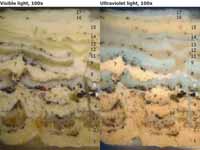 Sample TC3 from the middle of the soffit on the east cornice
Sample TC3 from the middle of the soffit on the east cornice
One sample was taken from the weatherboards on the west elevation which are thought to be original to the first period of construction. The material from this sample fractured making it hard to determine an exact stratigraphy. The best cross-section with evidence of early layers from this sample is shown below and begins with cream-colored paint layers with some wood cells still attached. These layers are coarsely-ground and have some grime but are considerably lighter in color than the earliest layers in the cross-sections from the cornice. The upper layers in the cross-section seem to correspond to layers found in generations fifteen through seventeen in cross-sections from the cornice. It could be that the first few layers are jumbled remnants of early finishes that survive while intermediate layers have been lost, but more sampling is needed to understand the finish history of the weatherboards.
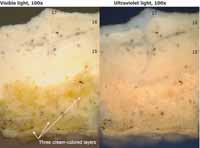 Sample TC7 from the top of the eighth weatherboard up on the west wall
Sample TC7 from the top of the eighth weatherboard up on the west wall
Other cross-sections from the weatherboards yeileded better evidence of later layers. With the exception of the first coarse cream-colored layer, the layers in this cross-section seem to correspond to generations fifteen through twenty in cross-sections from the cornice.
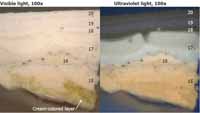 Sample TC7 from the top of the eighth weatherboard up on the west wall
Sample TC7 from the top of the eighth weatherboard up on the west wall
The one window sample taken from the north jamb of the north first-floor window on the west elevation should date to the first period of construction. The cross-sections from this sample do not have much evidence of early paints. Chappell noted that the window frame appeared to be an early element, so the finish history may have been lost due to wear or scraping. There does appear to be some fragments of dark cream-colored paint at the bottom of the cross-section that may be remnants of the original dark cream-colored paints, but there is too little evidence to be sure. Further sampling would be needed to identify the original finish of the windows.
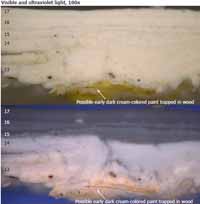 Sample TC8 from the north jamb of the north first-floor window on the west wall
Sample TC8 from the north jamb of the north first-floor window on the west wall
Results of Binding Media Analysis with Fluorochrome Stains
Selected cross-sections from the cornice with earlier layers were chosen for fluorochome binding media analysis. There was no visible reaction for proteins with FLUR in the early layers. Reactions for carbohydrates with TTC were visible only in generation six and above. DCF reacted strongly positively for oils in generation six and above. The early dark cream-colored layers appear to have turned slightly more pink when stained with DCF which suggests the presence of a saturated, aged oil binder. By contrast, layers after generation six became more yellow when stained with DCF which suggests an unsaturated, less aged oil binder. A linseed oil binder would be consistent with traditional eighteenth-century paint practices, however to fully understand the composition of the early binders, other analytical techniques would be needed, such as Fourier-transform infrared spectroscopy or gas-chromatography mass spectrometry.
 Sample TC3 from the lower fascia below cymatium on the east cornice
Sample TC3 from the lower fascia below cymatium on the east cornice
One cross-section was stained with TSQ which reacts positively for the presence of zinc (Zn2++)with a bright blue reaction color when viewed in reflected ultraviolet light. The cross-section stained positively for zinc (probably present in the form of zinc white pigment) in generation six and layers above. Since zinc white was not commercially produced before 1845, this helps to date generation six at least to after the second period of construction at the house in 1815-1834.
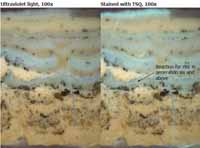 Sample TC3 from the lower fascia below cymatium on the east cornice
Sample TC3 from the lower fascia below cymatium on the east cornice
Results of Pigment Identification
Pigment identification with polarized light microscopy was undertaken on the first dark cream-colored paint layer. This target layer was scraped with a scalpel and the dispersed pigments were spread on a glass slide for examination. The dispersed pigments were compared to known pigments from a reference library and their optical and morphological properties were examined. No colored pigments were detected in the dispersed pigment samples, instead the paint appears to have only lead white and various other colorless extenders. The lead white pigments are large and rounded suggesting that this is a coarsely-ground, early paint. More modern production of lead white tends to produce much finer and more needlelike pigment particles.
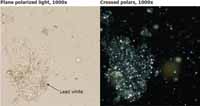 TC3, dispersed pigment sample from first dark cream-colored paint layer
TC3, dispersed pigment sample from first dark cream-colored paint layer
Results of Color Measurement
The CIE L*a*b* color system was used for color measurement in which L* represents lightness to darkness with 100 being the brightest, a* represents red to green with positive numbers being more red and negative numbers more green, and b* represents yellow to blue with positive numbers being more yellow and negative numbers more blue. All color measurements were made using a Minolta Chromameter CR-241 with a measurement area of 0.3mm.
Since the earliest dark cream-colored paint was found to contain lead white and no other colored pigments, its current color is probably due to embedded grime and darkening of the oil binder with age. A fresh paint composed of lead white in linseed oil would certainly originally have been much lighter, though not equal to a modern "cool" white. A batch of lead white in linseed oil paint prepared by Susan Buck was measured to have a CIE color value of L* 91.07, a* -1.26, b* 11.29. A good commercial paint match to this is Benjamin Moore OC-35 "Spanish White", which has a value of L* 90.69, a* -1.67, b* 10.31. This is different from the reproduction paint by a very low ΔE value of only 1.13. (Accepted values are within a ΔE value range of ±2, as the human eye has trouble differentiating between two colors below this value). Hence, this commercial paint match could be used for reproducing an unaged lead white in linseed oil paint that the evidence suggests was originally on the cornice and possible on the window and weatherboards.
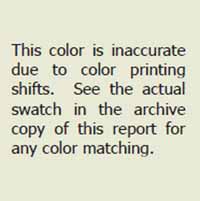 Benjamin Moore OC-35
Benjamin Moore OC-35
Best commercial match to fresh lead white in linseed oil
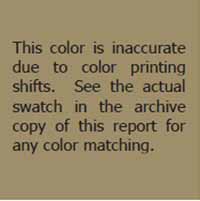 Benjamin Moore HC-20
Benjamin Moore HC-20
Best commercial match to aged original paint
A measurement was also made of the current color of the earliest degraded and darkened dark cream-colored paint. Two samples were selected from uncast material from samples TC3 from the cornice. Because the early paint is coarsely ground and weathered, its color is somewhat variable. Six color measurements taken from the uncast cornice samples and averaged to determine which measurement was closest to the average. The closest measurement from uncast samples to the average of all readings is L* 60.57, a* 1.33, b* 20.30. The equivalent Munsell color value of this uncast sample is 1.9Y 5.9 / 2.8. The best commercial match to the original degraded and darkened cream-colored paint found is HC-20 "Woodstock Tan", a Benjamin Moore paint. This paint has a color value of L* 59.85, a* 0.98, b* 22.43 which is different from the best actual reading by a ΔE value of 2.28. This color is significantly different than the paint would have appeared originally due to darkening and degredation of the paint with age.
Conclusion
The samples taken from the Taliaferro-Cole House cornice for this report did yield evidence of early paints. The earliest layers have coatings of grime and are coarsely-ground. They also have signs of age consistent with an eighteenth-century paint. The first five generations of paint are a dark cream color. The paints appear to be composed of an oil binder with lead white pigment. No colored pigments were detected in the first layer during analysis. This composition would have yielded a cream-colored paint when fresh, but the paint has significantly darkened with age probably due to degradation of the oil binder.
Similar early dark cream-colored paints were also found in the one sample taken from the weatherboards, but the evidence is too limited to be completely sure that these are the same paints as those found on the cornice. The one sample from a window did not yield sufficient evidence of early paint. Therefore, it is not possible to confidently date the cornice by comparison of its stratigraphy with that of the weatherboards or windows. However, generation six on the cornice contains zinc white pigment, which dates this layer to 1845 or after. The cornice on the east elevation is in an area added in the second period of construction, but it seems unlikely that six generations of paint would be applied between the second period of construction in 1815-1834 and the mid-nineteenth century when zinc white became commercially available. Thus, the section of cornice sampled for this report on the east elevation might date to the first period of construction and have been reused on the new east elevation.
The limited evidence in the one weatherboard sample suggests that the sides of the house might have been painted to match the cornice in the first generation and that the house may have originally had a monochromatic cream-colored scheme. The stratigraphies from both the weatherboard and the cornice begin with three dark cream-colored paints so this color treatment might have continued for some time.
Assuming that the cornice dates to the first period it is still not possible to determine which generation of paint dates to the second period of construction when the house achieved its current form. However, aside from generation three which has a few large orange pigment particles in some cross-sections, all the early paints are cream-colored. Therefore, repainting the house in a cream color to represent either the first or second period of construction seems appropriate.
Color measurements were taken from the first dark cream-colored paint on the cornice which is composed of lead white in linseed oil. A good commercial paint match was found for the current aged and degraded appearance of the first dark cream-colored paint. A commercial color match was also provided for a fresh lead white in linseed oil paint that would more closely replicate the original appearance of the first generation of paint. The Taliaferro-Cole house is currently painted with a bright white paint that is probably a cooler white and lighter than the oil-bound paints available in the eighteenth century.
Future work on this house might involve further sampling on the exterior to identify more original paint on the weatherboards since only one sample was taken for this report. The windows should also be sampled more fully to determine if there is evidence of the same dark cream-colored paint in the first generation as that found on the weatherboards and cornice.
Footnotes
Appendix
Sampling Memorandum
August 22, 2006
To: Natasha LoeblichFrom: Edward Chappell
Subject: Exterior Paint Samples, Taliaferro-Cole House
Block 13-1, Building 40
Attached are paint samples I took this afternoon from exterior woodwork at the Taliaferro-Cole House. I am relatively confidant that there are many layers of paint on the cornice samples (1-6) and suspect the layers from the west weatherboard and window (7-8) are much less intact, although the board and window frame are early. The south cornice appears to match the east cornice in form and age.
- 1.East cornice, bottom cyma of bed molding, bottom edge, 1' 2" south of north window
- 2.East cornice, fillet of bed molding between cyma and ovolo, 1' south of north window
- 3.East cornice, lower fascia immediately below cymatium, at south side of ninth modillion, counting from the north (front)
- 4.East cornice, lower fascia, 1" above bed molding, 2" south of ninth modillion, counting from the north
- 5.East cornice, ninth modillion, counting from north, lower south edge 1" out from fascia
- 6.East cornice, middle of soffit 3" south of ninth modillion, counting from the north
- 7.West wall, eighth weatherboard, counting from bottom, 2' 2" south of north first-floor window, at top adjoining weatherboard above.
- 8.West wall, north first-floor window, north jamb, inner edge, 1" below top sash.
E.A.C.
Cross-section Preparation Procedures
The samples were initially examined with a stereomicroscope under low power magnification (5 to 50 times magnification) and divided as needed. When possible, a portion of each sample was kept in reserve for future analysis and a portion cast in a labeled cube of a commercial two-part polyester resin manufactured by Excel Technologies, Inc. (Enfield, CT). The resin was cured under an incandescent lamp for several hours. The resin cubes were then ground on a motorized grinding wheel with 400 grit sandpaper to reveal the cross-sections. Final finishing was achieved using a Buehler Metaserv 2000 grinder polisher equipped with abrasive cloths from Micro Mesh, Inc. with grits of 1500 to 12,000.
Cross-section microscopy analysis was performed using a Nikon Eclipse 80i microscope equipped with an EXFO X-Cite 120 Fluorescence Illumination System fiberoptic halogen light source. The cross-sections were examined at magnifications of 40x, 100x, 200x, and 400x using reflected visible light and a UV-2A fluorescence filter cube with a 330-380nm excitation. The cross-sections were photographed digitally using an integral Spot Flex digital camera with Spot Advanced (v. 4.6) software. The light levels of the images were adjusted in Abode Photoshop (v. 6.0) when needed. The color in the digital images is indicative of the actual color of the paints, but cannot be used for color matching as the printing process can cause color shifts.
Under ultraviolet light many materials have characteristic autofluorescence colors that can suggest their composition. For example, most natural resin varnishes have a bright autofluorescence while an oil varnish will be dark in ultraviolet light. Visible light microscopy can also yield valuable information. The presence of soiling layers or weathering can indicate that the finish layer existed as a presentation surface for a period of time. Since many finishes make use of a build-up of layers, it is important to determine which layers were meant to be final presentation surfaces.
Binding Media Analysis Procedures
To better understand the composition of the paint binders, selected cross-sections were stained with biological fluorochrome stains to indicate the presence of carbohydrates, proteins, and oils in the paint binders. The stains used were FLUR (0.5% w/v fluorescamine in anhydrous acetone) which marks proteins blue-white, TTC (4% w/v triphenyl tetrazolium chloride in methanol) which marks carbohydrates red-brown, DCF (0.2% w/v 2,7 dichlorofluorescein in ethanol) which marks saturated lipids pink and unsaturated lipids yellow, and TSQ (0.2% w/v N-(6-methyl-8-quinolyl)-p-toluenesulfonamide in ethanol) which marks zinc (Zn2++) blue-white.
Pigment Identification Procedures
Samples with good accumulations of early paints identified through cross-section microscopy analysis were scraped with a scalpel under magnification to reveal the target paint layer. A small amount of this layer was then scraped onto a glass microscope slide, dispersing the pigments. The dispersed pigments were permanently embedded under a cover slip in Cargille Meltmount (Cargille Labs., Cedar Grove, NJ). The Meltmount used has a refractive index of 1.662. The prepared slides were then examined under the microscope with transmitted visible light using a polarizing filter at a magnification of 1000x with an oil immersion objective. The morphological and optical properties of the pigment particles was observed and compared to reference pigment samples.
Color Measurement Procedures
Color measurements were made using uncast samples that were selected under magnification. All color measurements were made using a Minolta Chromameter CR-241 with a measurement area of 0.3mm for uncast samples and a measurement area of 1.8mm for paint swatches. This microscope has an internal, 360° pulsed xenon arc lamp and can measure color with five color systems. The color systems used in this report are the CIE (Commission International de l'Eclairage) L*a*b* and the Munsell color system. Both systems use three values called tristimulus values to measure each color, which include hue (or color), the chroma (or saturation), and lightness to darkness. In the CIE L*a*b* color system L* represents darkness to lightness from 1 to 100 with 100 being the lightest, a* represents red to green with positive numbers being more red and negative numbers more green, and b* represents yellow to blue with positive numbers being more yellow and negative numbers more blue. In the Munsell system, color measurements are given in the form of hue value/chroma with value representing lightness to darkness. Color measurement values are compared to each other using the ΔE formula1 which calculates the difference between two color measurements. Generally, a ΔE value of less than two represents colors that are difficult for the human eye to differentiate.